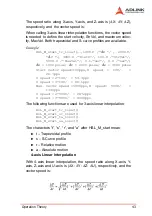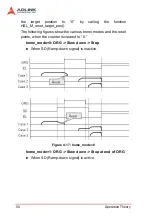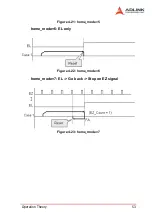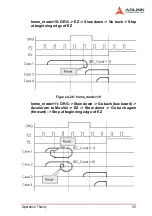
Operation Theory
49
change the (MaxV, MiniT) relationship to a higher value, (MaxV1,
MiniT1). Finally, the command would be:
HSL_M_fix_speed_range(AxisNo, MaxV1);
HSL_M_start_tr_move(AxisNo,Distance, 0 , MaxV2 ,
Target T, Target T);
Relative Functions:
HSL_M_fix_speed_range()
HSL_M_unfix_speed_range()
HSL_M_verify_speed()
Home Return Mode
In this mode, the HSL-4XMO is allowed to continuously output
pulses until the condition to complete the home return is satisfied
after writing the command HSL_M_home_move(). There are 13
home moving modes provided by the HSL-4XMO. The
“home_mode” of function HSL_M_set_home_config() is used to
select whichever mode is preferred.
After completion of home move, it is necessary to keep in mind
that all related position information should be reset to be “0.” The
HSL-4XMO has 4 counters and 1 software-maintained position
recorder. They are:
X
Command position counter: counts the number of pulse out-
puts
X
Feedback position counter: counts the number of pulse
inputs
X
Position error counter: counts the error between command
and feedback pulse numbers.
X
General-Purpose counter: can be configured as pulse out-
put, feedback pulse, manual pulse, or CLK/2.
X
Target position recorder: records the target position.
Refer to section 4.4 for a more detailed explanation about position
counters.
After home move is complete, the first four counters will be cleared
to “0” automatically, however, the target position recorder will not.
Because it is software maintained, it is necessary to manually set
Summary of Contents for HSL-4XMO
Page 4: ......
Page 16: ...6 Introduction ...
Page 36: ...26 Signal Connections ...
Page 67: ...Operation Theory 57 Home Search Example Home mode 1 Figure 4 29 Home Search Example ...
Page 108: ...98 Motion Creator in LinkMaster ...
















































